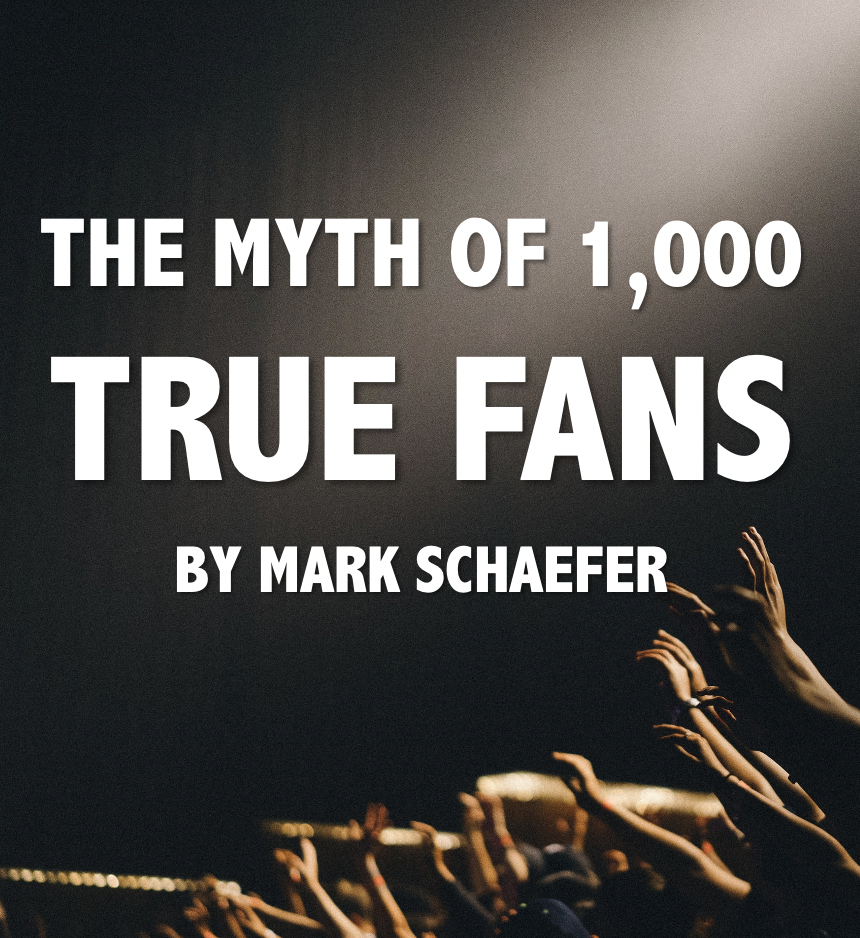
In 2008, Kevin Kelly wrote one of the most famous blog posts in the history of the web: “1000 True Fans.”
This famous treatise has been quoted hundreds of times on the web and has even become the core idea behind books about audience-building and monetization. Here is the core idea from his famous post:
“Here’s how the math works. You need to meet two criteria. First, you have to create enough each year that you can earn, on average, $100 profit from each true fan. That is easier to do in some arts and businesses than others, but it is a good creative challenge in every area because it is always easier and better to give your existing customers more, than it is to find new fans.
“Second, you must have a direct relationship with your fans. That is, they must pay you directly. You get to keep all of their support, unlike the small percent of their fees you might get from a music label, publisher, studio, retailer, or other intermediate. If you keep the full $100, then you need only 1000 true fans to earn $100,000 per year. That’s a living for most folks.
“A thousand customers is a whole lot more feasible to aim for than a million fans. Millions of paying fans is not a realistic goal to shoot for, especially when you are starting out. But a thousand fans is doable. You might even be able to remember a thousand names. If you added one new true fan per day, it’d only take a few years to gain a thousand.”
This concept seems so elegant, so achievable, so dead-simple that anyone can do it.
Except … you can’t.
The myth of 1000 true fans
First I’d like to establish that I deeply admire the author of this post, Kevin Kelly. He is wise and kind. If you ever get a chance to see him speak, do it, and I highly recommend his visionary book The Inevitable: Understanding the 12 Technological Forces That Will Shape Our Future.
Now, on to the point.
I’m pretty sure I have a 1000 true fans out there somewhere. Probably many times that. Here are my raw numbers:
- 170,000 Twitter followers
- 18,000 LinkedIn connections
- 20,000 blog subscribers
- 7,000 Instagram followers
- 15,000 monthly podcast downloads
Plus I have many other followers on places like Facebook, Medium, YouTube, not to mention clients and thousands of former students in my university classes.
These are not Beyonce-like numbers but they’re real. I don’t buy followers, I don’t play games. I rarely even follow people — these connections followed me because they apparently see some value in what I do.
I fully realize that most of these social media connections are weak relational links, meaning they are passive and would probably never buy something from me.
But surely if anybody has 1000 true fans it would be me, right?
The experiment
I t’s perilous trying to sell a book. The average lifetime sales of a self-published book is 250 copies. Even if you go through a big publisher the average number of book sales is 3,000. Almost nothing.
t’s perilous trying to sell a book. The average lifetime sales of a self-published book is 250 copies. Even if you go through a big publisher the average number of book sales is 3,000. Almost nothing.
But my books sell many thousands of copies because over more than a decade I’ve earned an audience and I have a smart marketing plan for the books. For Marketing Rebellion, my marketing expenses alone were in excess of $10,000.
The Marketing Rebellion book hit number one on two different Amazon categories, and it was a self-published book. That is a remarkable achievement without having the power of a New York City publisher behind me and I am certain I would have only had this success because of my promotional efforts.
But I’ve always had a nagging feeling … do I need all this promotion? If Kevin Kelly is right, shouldn’t I be able to sell at least 1,000 copies of a $10 Kindle book by just letting my fans know about it?
So I did an experiment.
In 2019 I released an e-book/audiobook called LESSONS: Essays to Help You Embrace the Chaos with minimal fanfare. My promotional effort was limited to simply telling my audience about it through:
- One blog post
- An email notification
- Several podcast episodes featuring stories from the book
- A few social media posts on Twitter, LinkedIn, and Facebook.
In the first year, my (relatively) publicity-free book sold an anemic 100 copies, basically breaking even on the out-of-pocket investment in the project.
LESSONS is a great and helpful book. The people who read it or listened to it loved it. I know I’m not necessarily comparing apples to apples, but somewhere between 100 books sold and my 2019 Amazon number-one best-seller is the value of publicity, even when you’re “known.”
Conclusion
Monetizing any product takes more than simply having 1000 true fans, even though on the surface, the math seems so simple.
In this very noisy and competitive world, simply telling your fans you have something to sell isn’t enough. You still have to promote the hell out of it. You have to build momentum for your product, and then build more momentum to sustain sales over time.
Having 1000 true fans or 100,000 fans doesn’t entitle you to anything. You still have to earn a customer’s loyalty, attention, trust, and money every day.
 Mark Schaefer is the chief blogger for this site, executive director of Schaefer Marketing Solutions, and the author of several best-selling digital marketing books. He is an acclaimed keynote speaker, college educator, and business consultant. The Marketing Companion podcast is among the top business podcasts in the world. Contact Mark to have him speak to your company event or conference soon.
Mark Schaefer is the chief blogger for this site, executive director of Schaefer Marketing Solutions, and the author of several best-selling digital marketing books. He is an acclaimed keynote speaker, college educator, and business consultant. The Marketing Companion podcast is among the top business podcasts in the world. Contact Mark to have him speak to your company event or conference soon.
Illustration courtesy Unsplash.com. Book links are affiliate links.


